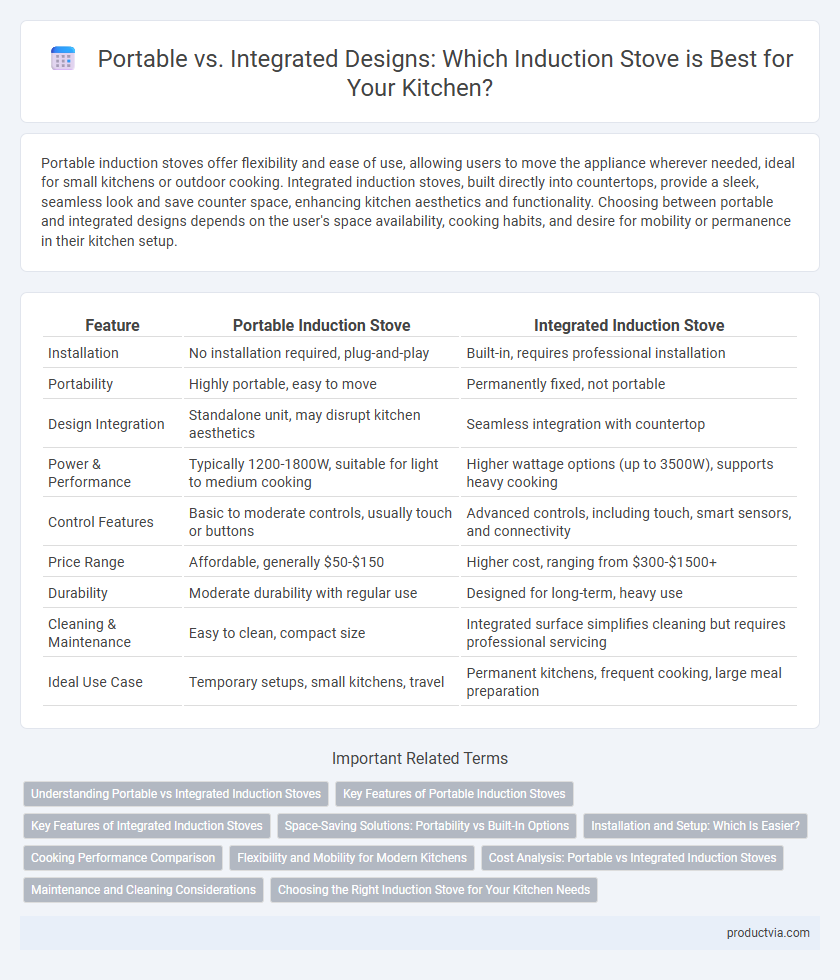Portable induction stoves offer flexibility and ease of use, allowing users to move the appliance wherever needed, ideal for small kitchens or outdoor cooking. Integrated induction stoves, built directly into countertops, provide a sleek, seamless look and save counter space, enhancing kitchen aesthetics and functionality. Choosing between portable and integrated designs depends on the user's space availability, cooking habits, and desire for mobility or permanence in their kitchen setup.
Table of Comparison
| Feature | Portable Induction Stove | Integrated Induction Stove |
|---|---|---|
| Installation | No installation required, plug-and-play | Built-in, requires professional installation |
| Portability | Highly portable, easy to move | Permanently fixed, not portable |
| Design Integration | Standalone unit, may disrupt kitchen aesthetics | Seamless integration with countertop |
| Power & Performance | Typically 1200-1800W, suitable for light to medium cooking | Higher wattage options (up to 3500W), supports heavy cooking |
| Control Features | Basic to moderate controls, usually touch or buttons | Advanced controls, including touch, smart sensors, and connectivity |
| Price Range | Affordable, generally $50-$150 | Higher cost, ranging from $300-$1500+ |
| Durability | Moderate durability with regular use | Designed for long-term, heavy use |
| Cleaning & Maintenance | Easy to clean, compact size | Integrated surface simplifies cleaning but requires professional servicing |
| Ideal Use Case | Temporary setups, small kitchens, travel | Permanent kitchens, frequent cooking, large meal preparation |
Understanding Portable vs Integrated Induction Stoves
Portable induction stoves offer flexibility and convenience, making them ideal for small kitchens, camping, or temporary cooking setups, while integrated induction stoves provide a sleek, built-in design that enhances kitchen aesthetics and maximizes countertop space. Integrated models generally offer higher power output and advanced features such as touch controls and multiple cooking zones, catering to more permanent installations in modern kitchens. Understanding the differences in installation, power capacity, and usability helps consumers choose the right induction stove to match their cooking needs and kitchen layout.
Key Features of Portable Induction Stoves
Portable induction stoves feature compact designs with lightweight materials, making them ideal for mobility and temporary setups. They offer adjustable temperature controls and energy-efficient technology that provides rapid heating and precise cooking performance. Integrated induction stoves, by contrast, are built into countertops for a seamless kitchen appearance but lack the flexibility of portable units.
Key Features of Integrated Induction Stoves
Integrated induction stoves feature a sleek, built-in design that seamlessly fits into kitchen countertops, enhancing aesthetic appeal and saving space. They typically offer advanced touch controls, precise temperature regulation, and multiple cooking zones to accommodate diverse culinary needs. Enhanced safety features such as automatic shut-off and child lock are standard, contributing to user safety and energy efficiency in integrated induction stove designs.
Space-Saving Solutions: Portability vs Built-In Options
Portable induction stoves offer flexible, space-saving solutions ideal for small kitchens, dorm rooms, or travel, allowing users to cook anywhere without permanent installation. Integrated induction stoves provide a sleek, built-in design that maximizes countertop space while offering a seamless look and enhanced functionality. Choosing between portability and built-in options depends on kitchen size, user lifestyle, and the need for mobility versus permanent space optimization.
Installation and Setup: Which Is Easier?
Portable induction stoves require minimal installation, simply plugging into a standard electrical outlet, making setup quick and hassle-free for any kitchen. Integrated induction stoves need professional installation, including fitting into a countertop and proper electrical wiring, which can be more time-consuming and complex. For those prioritizing ease and speed of setup, portable models offer a clear advantage over integrated designs.
Cooking Performance Comparison
Portable induction stoves offer flexibility and convenience with rapid heat adjustments, making them ideal for small spaces and quick meals, while integrated induction stoves provide superior heat distribution and consistent cooking performance due to their fixed installation and larger surface area. Integrated models typically support higher power outputs and multiple cooking zones, enhancing efficiency for complex meal preparation. Both designs utilize electromagnetic fields for precise temperature control, but integrated stoves excel in sustained heat uniformity and multitasking capability.
Flexibility and Mobility for Modern Kitchens
Portable induction stoves offer unmatched flexibility and mobility, making them ideal for modern kitchens where space optimization and adaptability are essential. Integrated induction cooktops provide a sleek, permanent solution seamlessly blending into the countertop, but lack the portability needed for multi-location use. Choosing between portable and integrated designs depends on the balance between convenience in relocation and the desire for a fixed, streamlined cooking surface.
Cost Analysis: Portable vs Integrated Induction Stoves
Portable induction stoves generally offer lower upfront costs, making them accessible for budget-conscious consumers and temporary use scenarios. Integrated induction stoves, while more expensive initially, provide long-term value with seamless kitchen integration and improved durability. Cost analysis reveals that portable models incur additional expenses over time through wear and limited features, whereas integrated units require higher installation investment but typically reduce maintenance costs.
Maintenance and Cleaning Considerations
Portable induction stoves offer easy maintenance and cleaning due to their compact size and detachable components, allowing users to quickly wipe down surfaces and access parts for thorough cleaning. Integrated induction stoves, often built into countertops, require more careful handling during maintenance to avoid damage to surrounding fixtures and may need specialized cleaning products to preserve their seamless installation. Choosing between the two depends on the user's preference for convenience versus a permanent, streamlined kitchen setup.
Choosing the Right Induction Stove for Your Kitchen Needs
Portable induction stoves offer flexibility and are ideal for small spaces or occasional use, featuring compact designs and easy storage. Integrated induction stoves provide a seamless look with built-in installation, enhancing kitchen aesthetics and often delivering more cooking zones and power options. Selecting between portable and integrated models depends on kitchen size, usage frequency, and desired functionality for optimal cooking performance.
Portable vs Integrated for Induction Stove Design Infographic

 productvia.com
productvia.com